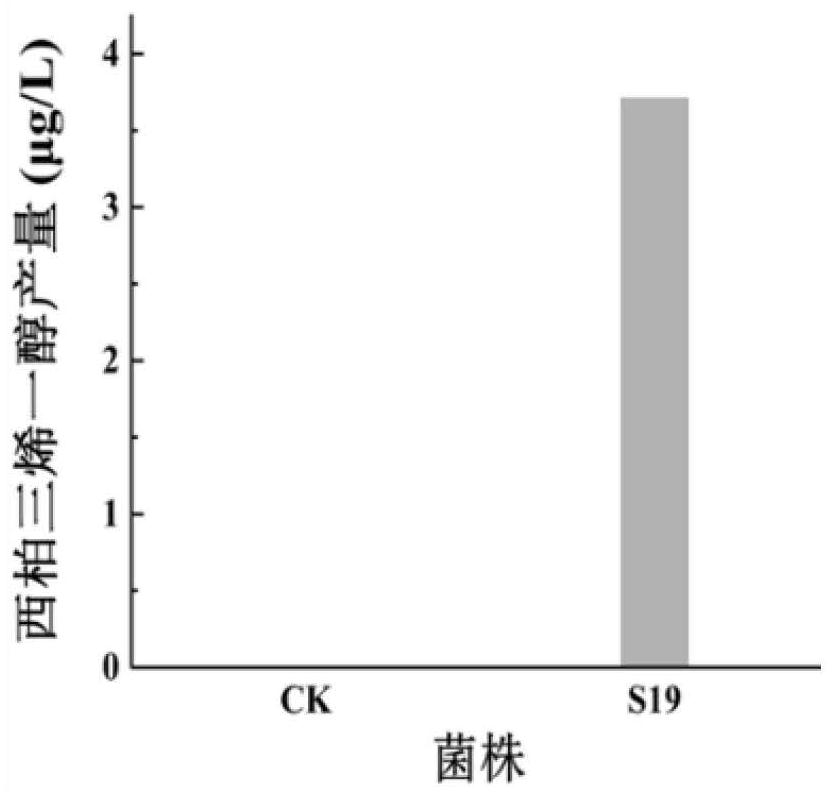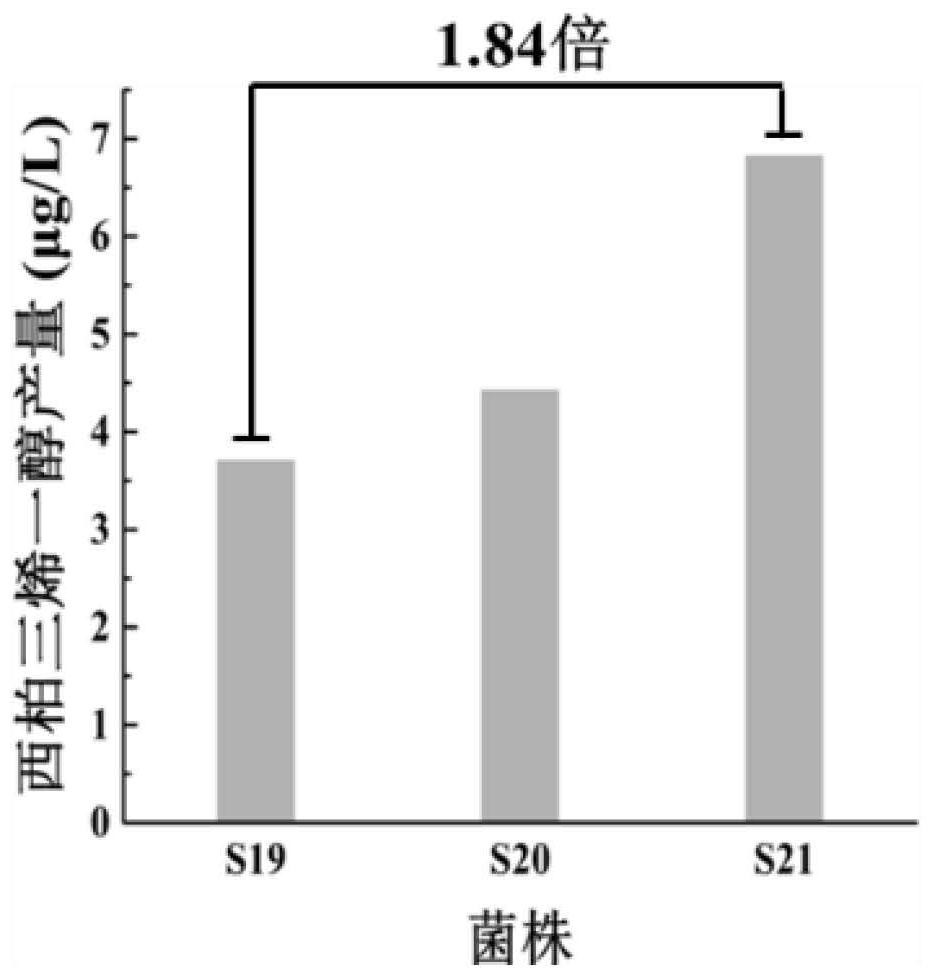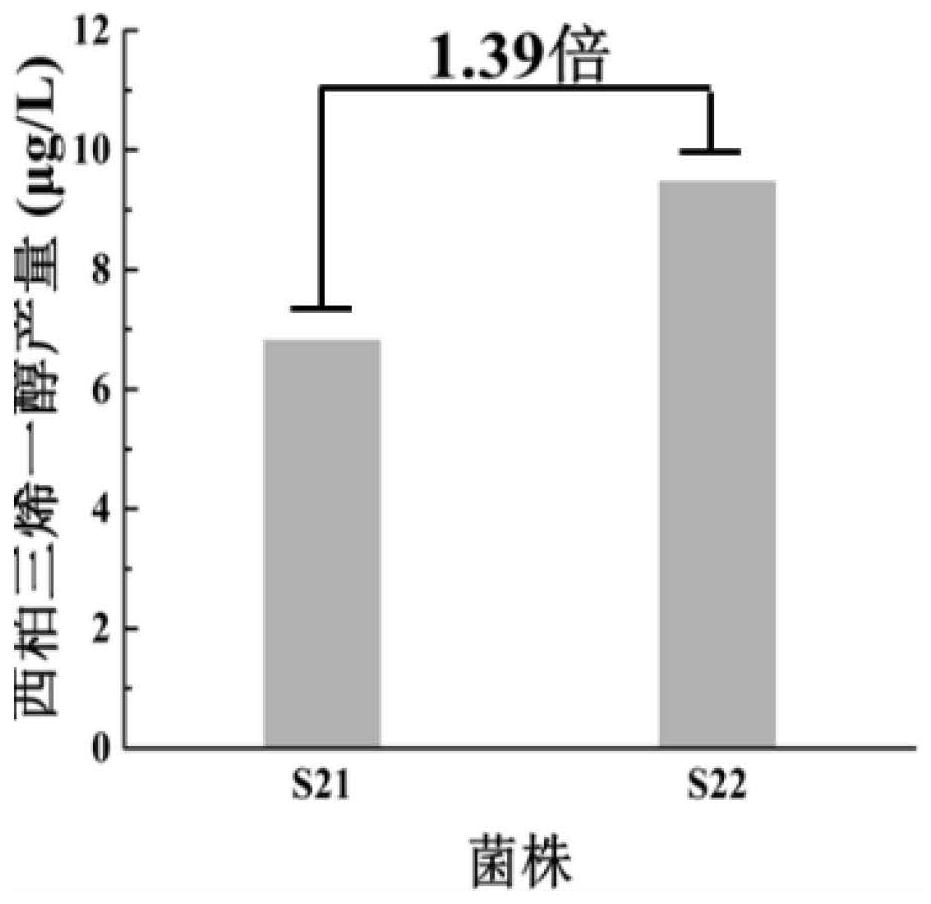Construction method and application of saccharomyces cerevisiae for producing cembratrienol
A technology of cerebrotrienol and cerebrotrienol synthase, which is applied in the fields of metabolic engineering and microbial engineering, and can solve problems such as unfavorable production of cerebrotrienol and the like
- Summary
- Abstract
- Description
- Claims
- Application Information
AI Technical Summary
Problems solved by technology
Method used
Image
Examples
Embodiment 1
[0035] The plasmid pY26TEF-GPD was used to heterologously express the GGPP synthase gene ggpps and the cembratrienol synthase gene cbts to realize the synthesis of cembratrienol in S. cerevisiae W303-1A. The specific construction method is as follows: use primer ggpp_tc_fusion_FW: CGGGATCCATGGCTTATACTGCTATGGCT;
[0036] ggpp_tc_fusion_RS: TGATAATGATAAACTGAGCTTTAATTTTGTCTAAAAGCGA;
[0037] GAP_g_G_t__FW: GTCGAATCTGTCGACATATGAGAGGGTTAATTGCGCGCCG;
[0038] g_G_t_fusion_2_RS: CGGCGCGCAATTAACCCTCTCATATGTCGACAGATTCGA.
[0039] Combine ggpps with the promoter P shown in promoter SEQ ID NO.7 GAP , the gene cbts shown in SEQ ID NO.2 is fused to PCR, digested with restriction endonucleases Bam HI and EcoRI, and then connected to the plasmid pY26TEF-GPD to obtain the recombinant plasmid pY26TEF-GPD-ggpps-P GAP-cbts. Then the recombinant plasmid pY26TEF-GPD-ggpps-P GAP -cbts were transformed into S.cerevisiae W303-1A to obtain recombinant strain S19.
[0040] A single colony of the ...
Embodiment 2
[0043] In this example, the cembratrienol synthase gene cbts and the farnesyl pyrophosphate synthase gene erg20 were expressed in tandem to construct a recombinant strain S21. The specific construction method is as follows: using primers
[0044] ERG20-1-FW:ATGGCATATACTGCAATGGCG;
[0045] ERG20-1-RS:TTAATTTTGTCTGAACGCGAT,
[0046] The gene ERG20 shown in SEQ ID NO.6 was amplified from the Saccharomyces cerevisiae genome, cloned in one step, and connected to the recombinant plasmid pY26TEF-GPD-ggpps-P constructed in Example 1 GAP -The 3' end of the gene cbts of cbts, obtain the recombinant plasmid pY26TEF-GPD-ggpps-P GAP -cbts-erg20. Then the recombinant plasmid pY26TEF-GPD-ggpps-P GAP -cbts-erg20 was transformed into S.cerevisiae W303-1A to obtain recombinant strain S21.
[0047] A single colony of the recombinant strain S21 was inserted into 20 mL of fresh YPD medium, and cultured in a shake flask at 30° C. and 200 rpm for 12 hours. Then the seed liquid was transferred ...
Embodiment 3
[0050] In this example, different S. cerevisiae host strains (S. cerevisiae BY4741) were used to produce cembratriene-ol. The recombinant plasmid pY26TEF-GPD-ggpps-P constructed and obtained in Example 2 GAP -cbts-erg20 was transformed into the strain S.cerevisiae BY4741, and the recombinant strain S22 was constructed. The cultivation method is the same as in Example 2.
[0051] Such as image 3 As shown, the cembratriene-ol production of the recombinant strain S22 was 9.5 μg / L, the conversion rate was 0.48 μg / g, and the production intensity was 1.32×10 -1 μg / (L·h), compared with the strain S21 yield that embodiment 2 constructs has significantly improved. The production of cembratrienol in strain S22 was 1.39 times higher than that in S21, which may be related to the growth of strain S.cerevisiae BY4741. It shows that S.cerevisiae BY4741 is more suitable for the production of cembratriene-ol than S.cerevisiae W303-1A.
PUM
 Login to View More
Login to View More Abstract
Description
Claims
Application Information
 Login to View More
Login to View More - R&D
- Intellectual Property
- Life Sciences
- Materials
- Tech Scout
- Unparalleled Data Quality
- Higher Quality Content
- 60% Fewer Hallucinations
Browse by: Latest US Patents, China's latest patents, Technical Efficacy Thesaurus, Application Domain, Technology Topic, Popular Technical Reports.
© 2025 PatSnap. All rights reserved.Legal|Privacy policy|Modern Slavery Act Transparency Statement|Sitemap|About US| Contact US: help@patsnap.com



